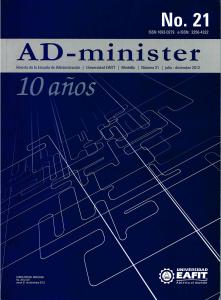Enfoque de opciones reales para la valoración financiera de marcas
Main Article Content
Keywords
Activos intangibles, marcas, valoración financiera de intangibles, valoración de activos financieros, opciones reales compuestas, marketing, JEL G1, G12, M31, O34
Resumen
Los activos intangibles, especialmente las marcas, son parte fundamental del valor de mercado de las compañías, pues representan su ventaja competitiva; sin embargo, la Contabilidad y las Finanzas se enfrentan ante un reto difícil al momento de valorarlos. Los métodos de medición de intangibles en la literatura revisada se caracterizan por ser limitados y subjetivos, e incluso presentan algunos errores conceptuales, encontrándose su utilidad principal en el campo de la gestión. Este artículo propone una metodología para la valoración financiera de marcas a partir de una extensión de la aplicación de opciones reales compuestas de las patentes, aprovechando las similitudes en su construcción. Su aplicación se ilustra mediante la valoración de la marca de una compañía aseguradora.
Descargas
Referencias
Andrikopoulos, A. (2008). Intellectual Capital and Real Options: Agency Theory and the Dynamics of R&D Investments. International Journal of Learning and Intellectual Capital, 5(1), 20-32.
Arregui, G., Rodríguez, A. & Vallejo, B. (2008). Opciones reales en la valoración de intangibles: la percepción de los directivos en el país vasco. Obtenido de http://dialnet.unirioja.es/servlet/articulo?codigo=2751702
Baldi, F., & Trigeorgis, L. (2009). A Real Options Approach to Valuing Brand Leveraging Options: how much is Starbucks Brand Equity Worth? Obtenido de http://69.175.2.130/~finman/Reno/Papers/RenoProgram.htm
Bouteiller, C. (2002). The Evaluation of Intangibles: Advocating for an Option Based Approach. Obtenido de http://www.departments.bucknell.edu/management/apfa/
Hamburg%20Papers/
Cox, J.C., Ross, S.A., & Rubinstein, M. (1979). Option Pricing: A Simplified Approach. Obtenido de http://fisher.osu.edu/~fellingham_1/seminar/
Damodaran, A. (2006). Dealing with Intangibles: Valuing Brand Names, Flexibility and Patents. Obtenido de http://ssrn.com/abstract=1374562
Edvinsson, L. & Malone, M.S. (1998). El capital intelectual. Cómo identificar y calcular el valor inexplorado de los recursos intangibles de su empresa. Bogotá: Norma.
Fernández, P. (2007). Valoración de marcas e Intangibles. Documento de investigación. No. 686. Obtenido de http://papers.ssrn.com/sol3/papers.cfm?abstract_id=975471
Iversen, E. J., & Kaloudis, A. (2003). IP-Valuation as a Tool to Sustain Innovation. STEP Report Series. The STEP Group, Studies in technology, innovation and economic policy. Obtenido de http://ideas.repec.org/p/stp/stepre/2003r17.html
Lambrecht, B. M. (2000). Strategic Sequential Investments and Sleeping Patents. En Project Flexibility, Agency and Product Market Competition: New Developments in the Theory and Application of Real Options Analysis (pp. 297-323). Oxford: Oxford University Press.
Lozano, M.C., & Fuentes, F. (2004). El valor de la marca y el valor de la empresa de internet. Investigaciones Europeas de Dirección y Economía de la Empresa, 10(1), 111-133.
Mantilla, S. (2004). Capital intelectual & Contabilidad del conocimiento. Bogotá: Ecoe Ediciones.
Organización Mundial de la Propiedad Intelectual –OMPI. (2009a). Principios básicos de la propiedad industrial. Publicación de la OMPI No. 895. Obtenido de http://www.wipo.int/freepublications/es/index.jsp?cat=intellectual%20property
Organización Mundial de la Propiedad Intelectual –OMPI–. (2009b). ¿Qué es la propiedad intelectual? Publicación de la OMPI No. 450. Obtenido de http://www.wipo.int/free publications/es/index.jsp?cat=intellectual%20property
Pakes, A. (1984). Patents as Options: Some Estimates of the Value of Holding European Patents Stocks. Obtenido de http://ideas.repec.org/a/ecm/emetrp/v54y1986i4p755-84.html
Picyk, A. (2005). Valoración de marcas. Obtenido de http://dx.doi.org/10.2139/ssrn.1496300
Salinas, G. (2006). El potencial de una extensión de marca. Infobrand digital. Obtenido de http://www.infobrand.com.ar/notas/7090-El-potencial-de-una-extensi%F3n-de-marca
Schwartz, E.S. (2003). Patents and R&D as Real Options. Economic Notes, 33(1), 23-54. Obtenido de http://www.nber.org/papers/w10114
Sereno, L. (2008). Real Options and Economic Valuation of Patents. Obtenido de http://www.academia.edu/657742/Real_options_and_economic_valuation_of_patents
Sereno, L. (2010). Real Options Valuation of Pharmaceutical Patents. A Case Study. Obtenido de http://dx.doi.org/10.2139/ssrn.1547185
Suárez, A.S. (2004). Opciones reales. [Documento de trabajo]. Obtenido de http://eprints.ucm.es/6820/
Sullivan, P. (2001). Rentabilizar el capital intelectual. Técnicas para optimizar el valor de la innovación. Buenos Aires: Paidós.
Teece, D. (1998). Capturing Value from Knowledge Assets: The New Economy, Markets for Know-How, and Intangible Assets. California Management Rewiew, 40(3), 55-79. Obtenido de http://apps.business.ualberta.ca/mlounsbury/techcom/readings/teece.pdf
Weeds, H. (1999). Sleeping Patents and Compulsory Licensing: An Options Analysis. Warwick Economic Research Papers, (577). Obtenido de http://privatewww.essex.ac. uk/~hfweeds/sleeping%20patents.pdf

